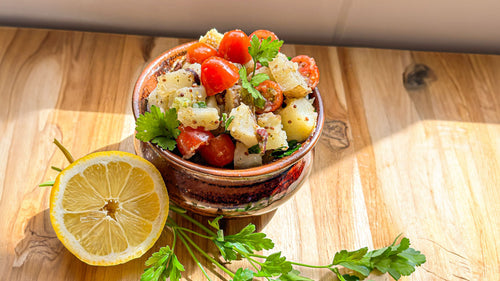
IBS 101: Learning to Love Fiber
Published on Thursday, October 21, 2021 by Allison KochUnless you are really trying...you’re probably not getting enough.
One of the common symptoms for two of the types of Irritable Bowel Syndrome is constipation. For individuals suffering from IBS-C or IBS-M, consistency with fiber intake may be the key to finding relief in the restroom. Constipation is one of the most common gastrointestinal complaints in the United States. The GI tract is highly sensitive to dietary fiber, and consumption of fiber seems to relieve and prevent constipation.
The current recommendations suggest that adult women should consume 21-25 grams of dietary fiber per day and adult men should consume 30-38 grams of dietary fiber per day. However, the average American only consumes 15 grams of dietary fiber per day! The best sources of fiber are fresh fruits, fresh vegetables, nuts and legumes, and whole-grain foods.
When you are reading a nutrition food label, you are going to see fiber listed as “dietary fiber” under total carbohydrate. Dietary fiber includes both soluble and insoluble fiber. Both of these fibers are important, but play different roles in the way they act in your body once you consume them.
Insoluble fiber is mainly made of plant cell walls and it cannot be dissolved in water. It has a good laxative action by bulking your stool and moving everything through. We call this in the nutrition world "Nature's Draino".
Soluble fiber is made of polysaccharides and does dissolve in water. It is beneficial to the body because it helps stabilize blood sugar levels and some studies have shown it can help lower blood cholesterol. The American College of Gastroenterology strongly recommends the use of soluble fiber in the treatment of IBS, since a diet that is richer in insoluble fiber can increase the chances of colonic fermentation.
Here are some additional tips to help you reach your fiber goals and help get your gut moving:
*Increase your fiber goals slowly and make sure to drink fluids whenever you consume foods containing fiber. Fiber cannot do its work in your body without having fluid as its vehicle to move everything along.
*Substitute legumes for meat 2-3 per week in chili and/or soups. Lentils, black beans, and pinto beans have about five grams of fiber per serving. If you are going low-FODMAP, check out these soups, which contain 3-4 grams of dietary fiber per serving: Roasted Pumpkin & Minestrone.
*Experiment with international dishes (such as Indian or Middle Eastern) that use whole grains and legumes as part of the main meals, or in salads.
*Remember, most people can get the biggest boost in dietary fiber by eating whole grain foods (like this gluten free pasta made from brown rice) and cereals.
*Look into new products on the market, such as these gluten-free, high-fiber tortillas.
Leave a comment on this article:
-
Allison Koch
PhD, RDN

Breastfeeding Tips for Infants with Reflux: Nourishing Your Baby's Journey

What to Eat and Drink to Conquer Bad Breath

Which Probiotic Is Best For Fatty Liver?

Optimizing Nutrition for Endurance Athletes: Preventing Runner’s Colitis

Gluten-Free, Dairy-Free Mediterranean Potato Salad
RECIPE INSIDE
Exploring Acid Reflux in Pets: Signs, Causes, and Remedies


